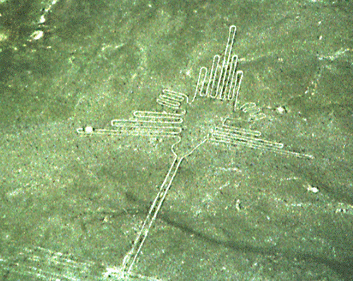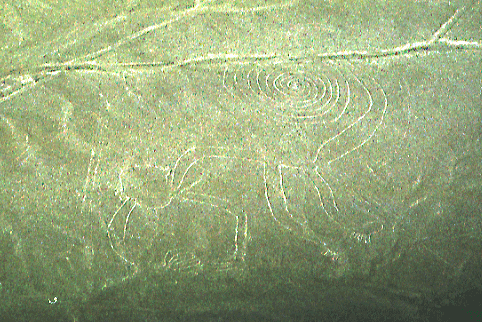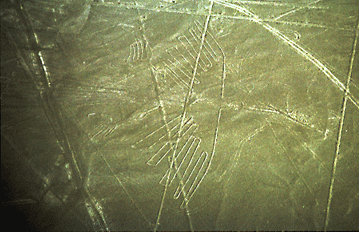
Gigantic figures engraved on the surface of the desert draw visitors to Nazca - figures representing plants, animals, birds and a variety of geometric shapes. These are the mysterious Nazca lines, situated 250 miles (400 km) south of Lima on the flatlands at the foot of the Andes.
"Mysterious" is the right word. What we know about them is very little. These strange markings were simply made - the dark stones were taken from the top, piled up on either side of the lines exposing the lighter soil underneath containing gypsum, and so the lines were formed.

We also know approximately when they were made - over a period of time between 900 BC and 600 AD, and by whom - successive cultures, the Paracas, the Nazca and finally the Wari.
The difficult question is "why?" The short answer - nobody knows.
Theories abound. They are an enormous astronomic calendar. The figures are representations of the animal familiars of the shamans. The lines were sacred paths and the spaces for religious gatherings. They are connected with burials. And possibly the most famous and controversial, they are extraterrestrial landing sites, as expounded by Erich von Daniken in his "Was God an Astronaut?" books. However, there is no conclusive evidence to support any of these theories. Just to add one last theory - as the shapes are only discernible from the air, research was done to prove that the Nazca people could have constructed hot air balloons. But to suggest that they did so is as much hot air!
The lines are fascinating to see - a variety of straight lines, spirals, zigzags, trapezoids, plants, birds and animals. And there is the so-called "owlman" on the hillside, possibly depicting the assistant of the mountain gods, strangely incongruous among the others. All of these really must be viewed by taking a flight in a light aircraft. They take up to nine people, although ours had only four passenger seats so all have a window seat, of course.

The pilots fly you over the designs, circling each one twice to give passengers on both sides a good view. It is difficult to take in the scale of these figures - the lizard is 600 feet (180 meters) long and the monkey with its elaborately curled tail is 300 feet (90 meters) in length. It is interesting to note that monkeys were known to those living in the desert coastal region, which evidences trade between these people and those from the forest.
